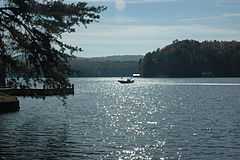Lake Burton (Georgia)
| Lake Burton | |
|---|---|
 | |
| Location | Rabun County, Georgia |
| Coordinates | Coordinates: 34°49′37″N 83°33′18″W / 34.8269°N 83.5551°W |
| Type | reservoir |
| Primary inflows | Tallulah River |
| Primary outflows | Tallulah River |
| Basin countries | United States |
| Surface area | 2,775 acres (1,123 ha) |
Lake Burton is a 2,775 acre (11.23 km²) reservoir with 62 miles (100 km) of shoreline located in the northeastern corner of Georgia in Rabun County.[1] It is the first lake in a six-lake series called the Tallulah River Watershed that follows the original course of the Tallulah River. The chain begins with Lake Burton as the northernmost lake followed by Lake Seed, Lake Rabun, Lake Tallulah Falls, Lake Tugalo, and Lake Yonah. The lakes are owned and operated by the Georgia Power Company to generate hydroelectric energy for Georgia's largest city, Atlanta. At one time these lakes were the largest producers of electricity in the state of Georgia. At present the lakes provide power only during periods of peak electricity consumption.
History and description
The lake was built in a deep valley located along a 10 mile (16 km) section of the Tallulah River.[1] The Lake Burton Dam was closed on December 22, 1919 and the lake started to fill. The dam is a gravity concrete dam, with a height of 128 feet (39 m) and a span of 1,100 feet (340 m). The spillway is equipped with eight gates 22 feet (6.7 m) wide by 6.6 feet (2.0 m) high. The total capacity at an elevation of 1,866.6 feet (568.9 m) is 108,000 acre·ft (133,000,000 m3), of which 106,000 acre·ft (131,000,000 m3) is usable storage. The generating capacity of the dam is 6,120 kilowatts (two units). Lake Burton is the highest Georgia Power lake in Georgia.
Lake Burton's name was derived from the town of Burton, which was the second largest town in Rabun County with a population of approximately 200. The former town now lies below the lake's surface. The town (and the lake) was named after local prominent citizen Jeremiah Burton and was situated along the road from Clayton, Georgia to the Nacoochee Valley. Andrew Jackson Ritchie served as the postmaster for the area for several years. Gold was first discovered in Rabun County where Dicks Creek and the Tallulah River come together and was the reason for the town's founding in the early 19th century.
The Lake Burton Fish Hatchery and Moccasin Creek State Park are located on the lake's west side. The lake is home to several species of fish, including spotted bass, largemouth bass, white bass, black crappie, bluegill, redear sunfish, white catfish, walleye, brown trout, rainbow trout, and yellow perch.
The residents of Lake Burton are a mix of permanent residents and seasonal vacationers who together make-up the Lake Burton Civic Association, a local organization who goal is to maintain the lake through volunteer clean-ups and other such events.
Events of interest
Fourth of July fireworks at Lake Burton have been an annual tradition for more than 25 years. The fireworks display was begun and continues to be run by a lifelong Lake Burton resident, Hal Rhoad. Though not a Lake Burton Civic Association sponsored event, the July 4th fireworks display is funded by donations from Lake Burton area residents and visitors. The fireworks are set off the Saturday before July 4 from Billy Goat Island, an island on the south side of the lake. Most people view the fireworks from boats driven near the island. As Lake Burton is set in the Appalachian Mountains the fireworks echo off the surrounding mountains, providing another auditory level to the visual feast of the fireworks.
YMCA Camp High Harbour
The YMCA of Metropolitan Atlanta operates its primary campus of Camp High Harbour near the headwaters of Lake Burton. This facility is the site of summer residential camps, leadership programs and youth retreats.
2011 tornado
A severe tornado struck Lake Burton on April 28, 2011. Among those killed was the Atlanta businessman E. Earl Patton, a former member of the Georgia State Senate.[2]
Notes
- ↑ 1.0 1.1 Brown, Fred (1996). The Georgia Conservancy's Guide to the North Georgia Mountains. Atlanta: Longstreet Press. pp. 154–155. ISBN 1-56352-314-0.
- ↑ "In Memory of Elbert Earl Patton, Jr.". obits.dignitymemorial.com. Retrieved May 21, 2012.